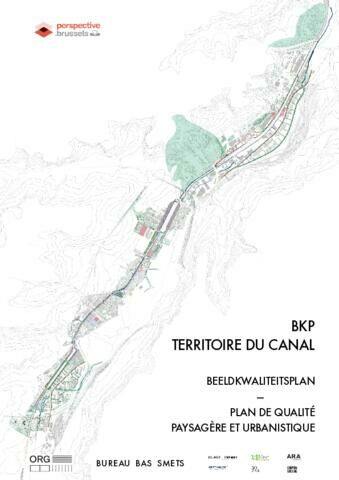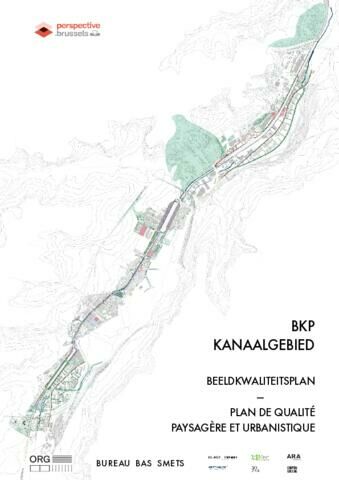- Home
- Urban projects
Urban projects
The territory of the Brussels-Capital Region is constantly developing. Learn more about our urban projects (French or Dutch)
- Urban issues
Urban issues
Housing, facilities, economy, land... perspective.brussels collects and analyses the data essential to the development strategy of the Region. Learn more about these urban issues (French or Dutch)
- Statistics and analyses
- Planning tools
- Who are we?
Canal open space plan
To boost the cohesion and to improve open space quality in the canal area, perspective.brussels is making available a landscape and urban planning quality plan – the canal open space plan – to relevant parties.
Description
Public and open spaces should enhance the quality of life in the canal area. They can connect different neighbourhoods, actors, and citizens. Open spaces allow for breathing space in this rapidly developing urban area, cultivating social connectedness, and offering ample leisure opportunities.
Subsequent to the development of the Canal Plan, numerous initiatives have been guided to translate the principles of density, functional mix, and urban integration into concrete projects. However, these projects demonstrated the need to complement and elaborate on the overall vision for the area's development with a specific strategy related to open spaces.
Strengthen the cohesiveness of the area through quality open spaces
Made available to all public space actors in the canal area, the Canal open space plan (also named Beeldkwaliteitsplan or BKP) meets two regional objectives:
- to promote cohesion within the canal area, strengthen its identity, and deliver high-quality public and open spaces;
- to solidify the social and green connections between the neighbourhoods, which are still too disrupted by the canal infrastructure.
A comprehensive guide
A comprehensive guide to open space development in the canal area
The COSP offers guidance and a strategic framework for property owners and designers of all projects with open space in the canal area. It was developed under the leadership of perspective.brussels by the consortium of Org Squared and Bureau Bas Smets in close collaboration with regional and municipal stakeholders.
A central procurement
A central procurement agency to facilitate the effective implementation of open space projects
perspective.brussels also established a central procurement agency and a follow-up committee to implement, monitor and update the COSP. The central procurement agency is designed to ensure the convergence of plans, studies, and projects with the vision and ambitions of the BKP, and to cultivate favourable dynamics for the transformation of the canal area.
The central procurement agency offers access to all open space actors in the canal area to use the BKP design team for their projects . The agency established partnerships with municipalities and regional agencies such as the city of Brussels, Anderlecht, Forest, Molenbeek, Brussels Environment, Brussels Mobility, the Port of Brussels, citydev.brussels, COCOF, and the Flemish Community Commission.
Lowering and greening of quays
On request of The Brussels-Capital Government Perspective commissioned an additional study to explore the possibilities for greening and lowering the quays in the canal area, aiming to strengthen the connection between public space, water, and nature.
This feasibility study was conducted in 2020 to:
- identify which quays in the canal area had the potential to be lowered and transformed to quality public spaces
- evaluate its technical and spatial limitations
- identify opportunities to green the canal, both at the canal banks and at waterway level.
Moreover, as proposed by Perspective, the Brussels government toke note of a specific feasibility study concerning a highly central segment of the canal area, and requested an examination of the implementation of lowering and greening the quays at 'Rederspark' (associated with Maximilian Park and the construction of the sports building at the Vergote Dock) and at 'Quai des Péniches'.
Updating the lighting strategy of the Canal open space plan
A comprehensive study of public lighting within the canal area was undertaken. It formulates proposals to achieve the following objectives:
- to maintain the ecological corridor's function during nocturnal periods;
- to use energy more economically;
- to improve safety along the canal.
Appropriate lighting takes into account the city's potential ecosystem services. Inadequate artificial lighting can adversely affect certain insect and animal species, attracting or repelling them. It is essential to limit light pollution and nuisance, similar to air or water pollution, to preserve the well-being of people and nature.
In order to minimise disruption to our biorhythms and natural ecosystems, the darkness of the night sky should be preserved to the greatest extent possible, whilst also valorising the landscape (encompassing architecture and urbanism) and enhancing the sense of safety for all users.
All of this aligns fully with the European Commission's Green Deal, the action plan for a climate-neutral Europe by 2050. The plan aims to promote resource efficiency by shifting to a clean and circular economy, restoring biodiversity and reducing pollution.
Individual copies of the additional studies on lighting, the lowering and greening of quays, whose key findings are incorporated into the Canal open space plan, updated in 2024, are available on request.
First tangible results now visible on site
Since the drafting and approval of the Canal open space plan, several concrete projects saw the light of day. These are projects implemented according to the plan’s principles or projects implemented using the plan’s central procurement agency.
Transforming the Chaussée de Vilvorde into a qualitative and multimodal road axis
Early 2022, the section along Chaussée de Vilvorde, between the Pont de Buda and the cruise terminal, was redesigned according to the COSP’s principles. Green planting strips delineate the roadway from the new pedestrian and cycle path. This ensures the safe movement of pedestrians and cyclists, allowing them to enjoy the pleasant water views.
Greening of the Quai de l'Industrie
At the Quai de l'Industrie, near the redevelopment of 'La Grande Halle', in Molenbeek, a renovation project has been carried out to replace the existing small square tree beds with large planting beds, between which a number of benches have been installed, arranged to create urban lounges. This revamped quay not only contributes to the COSP's landscape vision, the solidifying of the ecological network, and the amelioration of the quayside footpath, but also offers urban salons and other functions, promoting the quay’s multifunctional use.
Creating a promenade along the Quai de Biestebroeck
During spring 2022, the municipality of Anderlecht completed the construction of a pleasant, wide footpath on the Quai de Biestebroeck, adjacent to the Bassin de Batelage, at the junction with the Petite Île bridge. This footpath offers a beautiful view of the dock's large and green-lined water surface. Following the recommendations outlined in the COSP, paths in natural stone were constructed, and the original quayside capstones and railings were preserved. To strengthen the identity and cohesion of the canal area, future interventions should consistently apply the COSP's recommendations for generic public quays, specifically the reuse of historically recognisable elements, materials, and colours.
Strengthening the vital connection between people, water and the natural environment
The Brussels government's policy statement articulated a willingness to strengthen the connection between nature, people, and water. In this sense, the lowering and greening of the quays and canal were analysed in a feasibility study.
In April 2022, the Port of Brussels and Brussels Environment, installed the first floating green 'islands' near the Brussels Royal Yacht Club (BRYC). Through the workings of the vegetation, these islands improve water quality, increase biodiversity and absorb heat from the canal.
Publications
Contact
SvenVercammenChargé de projetProjecthouder

